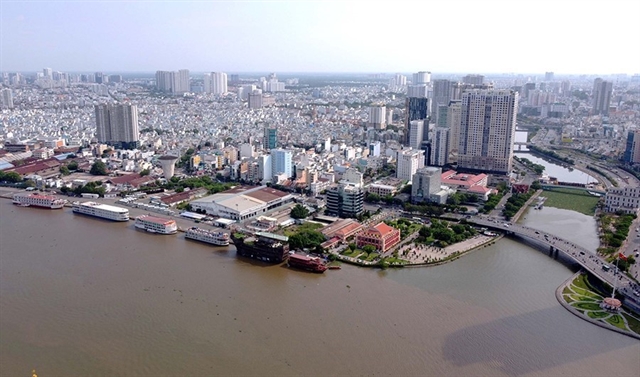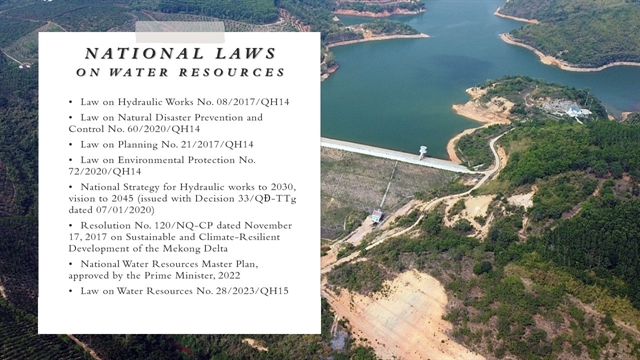 Society
Society

By Trọng Kiên
 |
| Trùng Lake, Vĩnh Phúc Commune, Bắc Quang District, Hà Giang Province, is one of the better maintained irrigation lakes in the northern mountainous locality. VNA/VNS Photo Nam Thái |
Việt Nam theoretically has the advantage of an extensive network of rivers and streams with favourable topography and abundant rainfall, but the water security situation becomes a much more complex issue upon closer examination.
Việt Nam has nearly 3,500 rivers and streams with an average length of 10 km or more and the total annual runoff is about 830 billion cu.m, but water shortages are still a real problem that is increasingly exacerbated by climate change.
While heavy rains are common in Việt Nam, the distribution throughout the year or among the regions is not equal, the dry season in the country is pretty long, between six and seven months when the runoff only accounts for 15-30 per cent of the total.
Then there's climate change impact, the escalating exploitation of water resources by upstream countries, plus the country's own high demands for water to use for social-economic activities, that have led to such serious water-related issues such as water pollution, or severe drought and floods.
More than 50 per cent of river basins in the country are already suffering from or will suffer from water shortages by 2030 and the situation is predicted to get worse over the years.
There are four major groups of challenges – social, economic, ecological and institutional ones – facing Việt Nam, according to Nguyễn Thuỳ Anh, head of the Development Cooperation Board, the Department of Water Resources Management (under the Ministry of Natural Resources of Environment or MONRE).
Việt Nam saw a rapid increase in population by 40 per cent between 1992 and 2015, leading to greater demands and pressure on water resources and related infrastructure.
Anh said this posed a social challenge, while Việt Nam also boasted good annual growth – around 6 per cent from 2012 to 2021, so the structure of Việt Nam's economy had been fundamentally reshaped and the competition for water use in different sectors was increasing.
It should be noted too that Việt Nam is highly dependent on water resources not within its control, with seven out of 13 major river basins in Việt Nam being transboundary, with more than 63 per cent of the total water resources generated outside of the border. The two biggest mainstay rivers of Việt Nam - the Red River in the north and the Mekong River in the south - that harbours the two biggest population centres and economic hub of the country, relies on 50 per cent and 90 per cent, respectively, of water outside Việt Nam's borders.
Calculating the total groundwater reserves across the entire territory of Việt Nam, the amount of water from outside the territory and the additional water from rainfall, the average amount of water per capita in Việt Nam is about 8,610 cu.m/person/year, which is higher than the regional and global standards. However, if you consider only internal water sources, the picture is worrying, as the average amount of water per capita is only 3,280 cu.m/person/year, lower than the Southeast Asian average of 4,900 cu.m/person/year and the global average of 4,000 cu.m/person/year.
What this means is that the country is highly susceptible to water insecurity, according to Anh.
The combined threats related to water resources can cause around 4.3 per cent GDP reduction each year and if no action is taken by 2035, the GDP of Việt Nam will be reduced by 3 per cent, with agriculture bearing the brunt.
Institutions-wise, there is overlapping/conflict between different ministries managing water resources – the MONRE is in charge of water resources in general – from source to sea, but the Ministry of Agriculture and Rural Development (Department of Water Resources) is in charge of water for crop production and for rural areas, while the Ministry of Construction (Technical Infrastructure Agency) remains in charge of water supply, especially for urban areas.
 |
| Việt Nam's national laws on water resources. |
Sustainability measures
Anh noted measures that the central government and concerned authorities had been active in developing to improve the water security situation and guarantee sustainable development of this critical asset.
First and foremost, it aims to enhance water resources management institutions, build a better legal framework and strategies for managing water.
Four major river basin plans have been completed and it's expected that by the end of the year, all of 16 major river basins will have their own plans.
Second, Việt Nam strives to increase the value produced by water in agriculture and increase the water use efficiency.
Third, water pollution is a major headache at the moment so the priorities will be given to water restoration efforts. For example, MONRE has put forward a programme for restoring the Bắc Hưng Hải irrigation system -- one of the bigger systems in the northern delta, but is facing the existential threat of severe pollution.
Finally, it is imperative to improve risk management and disaster response and to strengthen resilience, according to Anh.
It is time to consider water resources as a type of goods and there must be market-based financing and incentive for this special type.
"To enhance the water security we cannot only depend on the State budget because it's very limited," she said, "so they are pushing for public-private partnership for more diversified forms of investment partnership."
At the United Nations Water Conference held in Argentina last year, representing Việt Nam, Deputy Prime Minister Trần Hồng Hà, also a former environment minister, said the country had been implementing numerous policies and solutions to strengthen the management, effective protection, exploitation and sustainable use of water resources, ensuring the achievement of Sustainable Development Goals in line with the UN 2030 Agenda.
"Việt Nam continuously strives to enhance and strengthen its institutional and policy frameworks, ensuring that people have access to clean and sanitary water. The country is committed to maximising the benefits water provides, while minimising water-related harms, contributing to economic development and enhancing the quality of life for its citizens," Hà said.
In terms of specifics, Việt Nam is committed to the goal of having 100 per cent of large river basins regulated and a complete water resource plan and that by 2030, 100 per cent of urban households will have access to clean water that meets standards. — VNS




